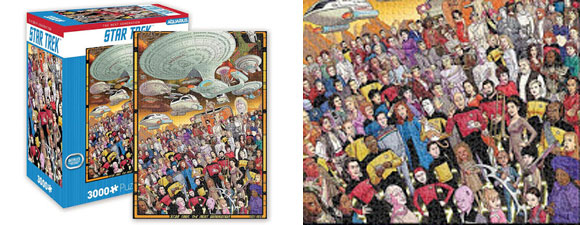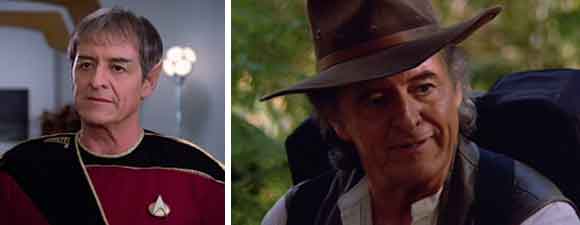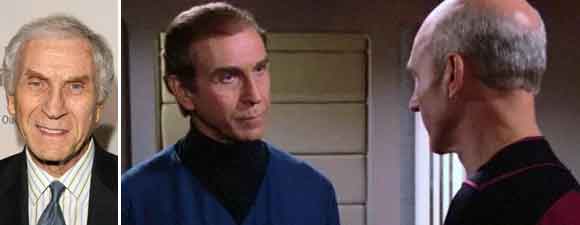Retro Review: Rightful Heir
8 min readThe legendary warrior Kahless returns from the dead, precipitating first a crisis of faith, then a crisis of Klingon politics.
Plot Summary: Picard confronts Worf about his erratic behavior since returning from the mission during which Worf rescued a group of young Klingons who knew nothing of their heritage. Worf explains that he has been trying to experience a vision of the mythic warrior Kahless, who promised to return and unite the Klingons once more. Picard allows Worf to take a shuttle to Boreth, a planet circling the star from which Kahless had said he would return. At first Worf cannot summon a vision there either, but after advice from one of the priests, he chants around the fire and is astonished when Kahless appears in the flesh, proving his identity by telling the story of how he forged the first bat’leth – a tale known only to the priests, kept out of the sacred texts. Worf’s tricorder tells him that Kahless is Klingon, but when the Enterprise offers Kahless passage to the Klingon homeworld, Worf still has doubts about why this Kahless does not recognize artificial Klingon wine nor recall the names of all his adversaries. Gowron arrives, announcing that this is all a trick by the priests to take control of the Empire; he challenges and defeats Kahless in combat, yet a medical scan of an antique dagger supposedly stained with the blood of Kahless proves that the blood is a genetic match for that of the Kahless who appeared on Boreth. Despite Gowron’s victory in combat, several of Gowron’s own warriors remain on the Enterprise to see Kahless. The priests suggest claiming that Gowron cheated, which angers Worf, who witnessed the fair fight. He demands the truth and learns that the priests used a sample of the blood from the dagger to clone Kahless, then imprinted memories constructed from the sacred texts to create a pure leader uncorrupted by power like Gowron. Worf insists on telling Gowron the truth, but he also insists that the Klingons need an emperor who can serve as a moral leader to their people. Since the legend of the return of Kahless is already spreading, Gowron agrees to let Kahless serve as a figurehead so long as political power remains with the High Council. Seeing that Worf’s crisis of faith has only deepened, Kahless tells him that whether or not the real Kahless waits in Sto-Vo-Kor, he left a powerful legacy – a way of thinking and acting – and if it is honorable, then that is more important than the man himself.
Analysis: There are a number of flaws in “Rightful Heir” – some concerning Klingon continuity, some in character consistency – yet it’s one of my favorite episodes of The Next Generation‘s sixth season. Star Trek rarely takes on the importance of religion, or when it does, it tends to be mocking or dismissive, such as McCoy joking that he wants to pretend to be the messiah in “Bread and Circuses” or Picard suggesting that humans have outgrown gods in “Who Watches the Watchers.” As fond as I am of Picard struggling with being worshipped in the latter episode, I’m even more fond of Worf’s crisis of faith, which simultaneously shows his Klingon devotion and gives him something in common with many humans. The episode opens with Worf nearly setting his quarters on fire while trying to force a vision, which gets him into trouble with both Riker and Picard, each of whom is sympathetic to his emotional state but neither of whom can tolerate his inattention to duty. The fact that Picard treats this nearly like a medical leave is interesting; once again, Picard lets Worf take a shuttlecraft for a personal quest, and while there would have been some implications for Starfleet and the Federation if Worf had indeed found his father alive in a Romulan prison camp, the search for Kahless is entirely personal to Worf, which suggests how highly Picard values him as a crewmember. (I’d love to know whether Picard would be so quick to give a human crewmember a shuttle to go home for Easter or Passover.)
The image of Worf in his quarters surrounded by candles and a fire-pit is unforgettable, and while I’m not terribly fond of the oft-shown matte painting of the temple on Boreth, the caves during the Klingon ritual trances look smoky and stuffy and dizzying. It’s not surprising that after days of ritual chanting in such an atmosphere, people have visions of Kahless. Worf does not appear to doubt anyone else’s claim to see the legendary warrior, but when he touches solid flesh and is told from the messiah’s own mouth that Kahless has returned, it brings out the skeptic rather than the believer in Worf. A tricorder reading convinces him that Kahless is not an enemy trick, no shapeshifter or hologram, but although Worf appears to like the man, he never fully trusts in the miraculous return. At the same time, he doesn’t have a lot of patience with those who insist on dismissing any possibility that Kahless might be the real thing, whether it’s his friends on the Enterprise, whose only agenda is scientific, or Gowron, who has a strong political motive for wanting to discredit Kahless and the clerics whom he empowers. Worf actually utters Fox Mulder’s catchphrase, “I want to believe.” We never get an explanation for how Kahless knows of Worf’s childhood experience of a vision of Kahless in a cave; Worf had no contact with Klingons during his childhood in Earth and indeed very little experience of Klingons when he arrived on the Enterprise, yet Worf accepts Kahless’s statement as true, so if Worf told Korath, how did Korath pass on the information to Kahless without making the latter aware that it was not his own memory?
Worf accepts Kahless’s challenge to fight, but he seems dispirited by the idea, and indeed, Kahless observes that he is not a merry man – he takes no joy in being Klingon when they duel. “How can you not sing?” Kahless asks him before leading the others in a rousing chant of “We are Klingons” (I keep wanting to add, “hear us roar!”). Kahless appears just as happy when challenged by Gowron and isn’t even all that distressed at the idea that the younger warrior may kill him before Worf intervenes. Even though Kahless’s weakness is Worf’s proof that this is not the real warrior of legend, he suspects that the duplicity comes from the priests, not from Kahless himself. Worf likes even this copy of Kahless better than he likes Gowron and the Council’s scheming. And although the priests have told him an enormous lie and manipulated him into giving their Kahless legitimacy, Worf appears to trust them with the moral future of his people more than he trusts Gowron. He likes Kahless and always speaks directly to him, rather than to the priests who created him yet quickly find that they cannot control him. The implication that the desire for a god will outweigh any practical challenges to belief is quite compelling. Star Trek’s writers may declare that all human religion has faded away like so much superstition, yet this episode suggests that no amount of science can destroy a strong enough faith. Even Data seems envious of this possibility, since he is incapable of faith beyond scientific reasoning. Since the Klingons are fictional, it seems like an apology of sorts to people of faith who are fans of the show while at the same time keeping science at the forefront.
There was a group on Earth in the late 1990s that proposed to clone Jesus Christ from genetic material in the Shroud of Turin, and “Rightful Heir” seems based upon a similar notion. It suggests that the Klingons are very unified in their spiritual beliefs, because my guess is that if one Christian group claimed to have cloned Jesus, many others would immediately repudiate it no matter where the genetic material originated. Surely someone would claim that the knife itself did not contain the real Kahless’ blood, or that it might have been corrupted over centuries? Gowron is utterly disinterested in the question of whether Kahless might be the real thing, or indeed whether there is a Sto-Vo-Kor after death; his only concern is how much damage this Kahless could do if anyone believes in him. It’s tempting to quote Monty Python’s Life of Brian, one of my favorite commentaries on the insidious and inspiring powers of religion: “I say he is the Messiah, and I should know, I’ve followed a few!” And yet the idea is so compelling, even for a nonbeliever like myself: What if we could look at Christ’s genome? If all the human genetic material came from Mary, what’s on the Y chromosome? What would God’s DNA look like — does it necessarily contain the junk strands that we find in all human DNA? Kahless isn’t alleged to have a divine origin, only a divine destiny, so these sorts of questions don’t get brought up in the episode, but they rise to the surface while watching it nonetheless.
This is a religious revival sparked by the finest example of cloning we’ve yet seen in the franchise. Who knew that the Klingons, even their isolated clerics, had such technology? The fact that there haven’t been Clone Wars speaks well of them. I’m sure I’ve made it clear that I’m not a fan of patriarchal Klingon society as presented on Next Gen, which is quite different from the brutal yet seemingly more egalitarian society of the original series and its films, yet somehow it doesn’t bother me that the Klingons have a male Jesus figure; in fact, the parallels with Christianity emphasized by the return of Kahless help explain why the more “civilized” Klingons of the new era actually seem more sexist than the earlier Klingons whom Kirk often treated like barbarians. I wish we’d heard more of Kahless’s teachings, but at the very least, I hope the Duras sisters asked him whether it was his wish that women not sit on the High Council. It would really irritate Gowron to have Kahless demand that that restriction be overturned, and one would hope Kahless would think that it was also the right thing to do.






